Recycling Marine Debris Through the Yaeyama Beach Clean Project
Results of FY2022 Survey on implementation status of Educational Travel to Japan
Japan National Tourism Organization (JNTO) surveyed organizations and associations nationwide accepting educational travel to Japan (e.g., prefectural tourism divisions and tourist associations) on the acceptance of educational travel to Japan in FY2022.
The responses obtained from total 47 organizations and associations, across all prefectures, were compiled, and a summary is provided on this page.
In FY2022, in-person school exchanges were able to resume due to the significant relaxation of border control measures to prevent the spread of COVID-19 in October. At the same time, many schools continued conducting online exchanges, which serve as an alternative when in-person exchanges are not possible. This year, we conducted a survey on the implementation status of school exchanges in both in-person and online formats.
Please note that the responses collected are based on the understanding of the staff member who completed the questionnaire, and may not accurately reflect the circumstances of each area.
1. Matching of School Exchanges in FY2022
The survey asked about the implementation status of both in-person and online formats. 65% of the in-person respondents said they matched with a school with which they had prior exchanges, while this was the case for 24% of the online respondents. Only 2% of the in-person respondents said that they matched with schools with which they had no previous exchanges, but for the online exchanges, the number was 27%. In the “other” category, some respondents said that they were unaware or had no experience facilitating exchanges through local governments. There were also responses indicating that they had received requests for exchange from schools overseas but were unable to conduct them because the prefectural government was not ready to handle the request.
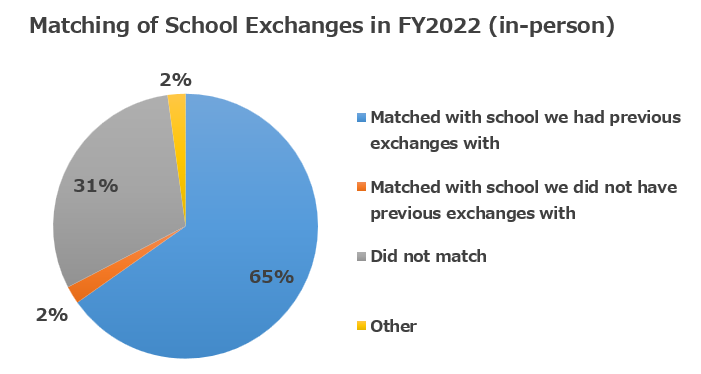
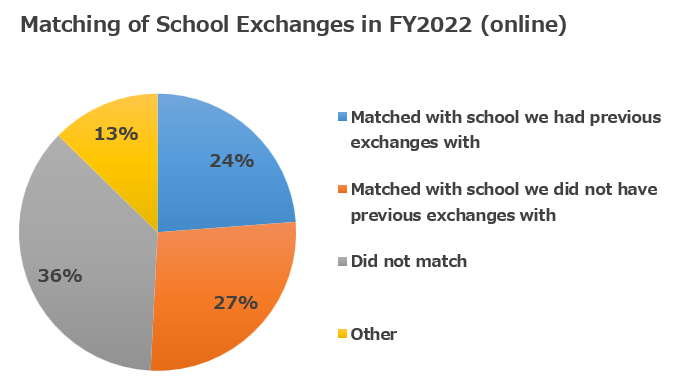
2. Percentage of Number of Exchanges by country/region
In terms of the number of exchanges by market, the largest number of participants came from Taiwan in both the in-person and online formats, with the online format in particular accounting for 64% of the total. While in-person exchanges were limited to certain regions, online exchanges were conducted with a wider variety of regions compared to the previous year.
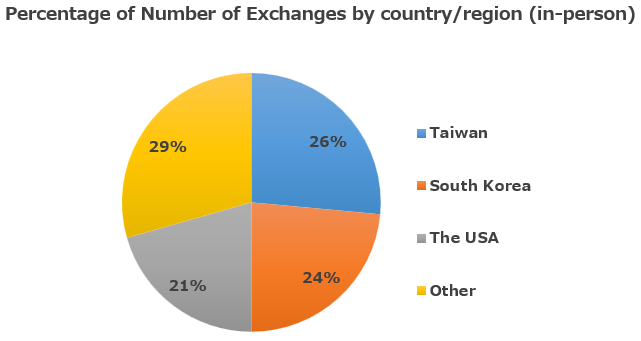

3.Percentage of number of schools which held school exchanges
For in-person exchanges, high schools accounted for 84% while no middle schools participated. In the online format, high schools accounted for 72%, followed by middle schools at 13% and elementary schools at 12%.
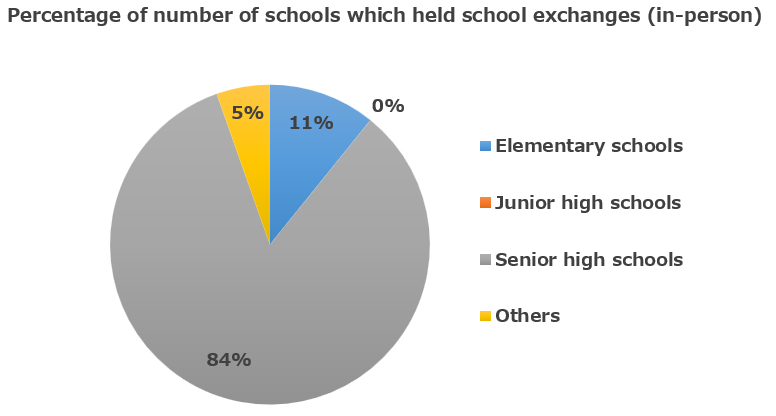
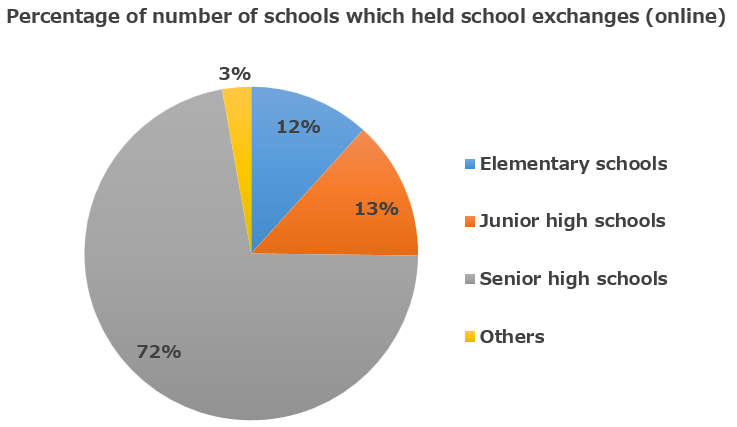
4.Tools used in online exchanges
Online exchanges were conducted using mainly video conference tools. We examined which tools were most utilized. Results showed that Zoom was the most used tool at 53%, followed by Google Meet at 28%. Teams accounted for 16%, a significant increase compared to the previous year.
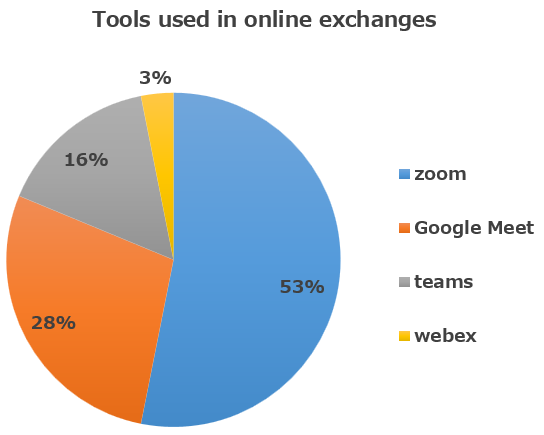
5.Average interaction time of exchanges
On average, 50% of respondents in the in-person format reported 3-5 hours of interaction, while 55% of respondents in the online format reported 60 minutes. In the in-person format, 20% of respondents reported 7 hours or more, while in the online format, all schools reported 120 minutes or less.
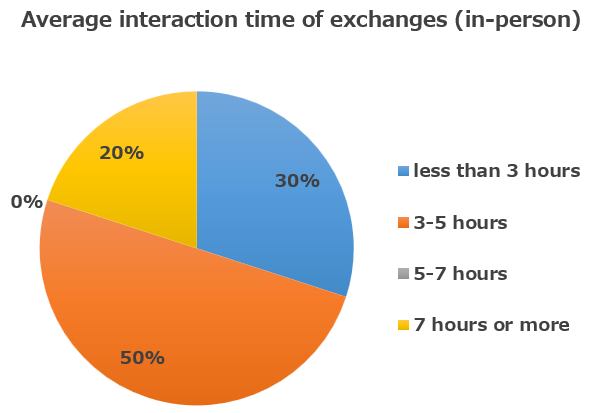
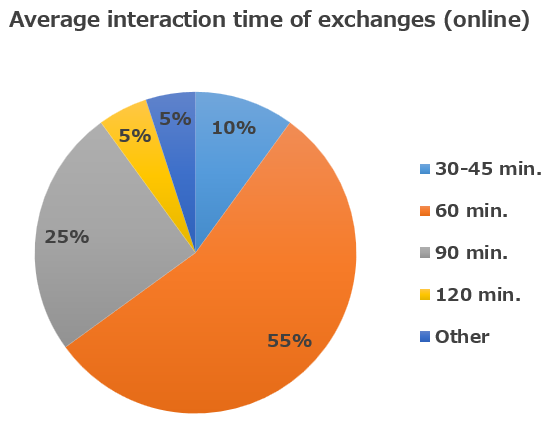
6.School exchange contents
When we asked about the contents of school exchanges, we received the following responses:
In-person format
Cultural Exchanges
In addition to calligraphy, tea ceremony, koto (Japanese harp), and trying on yukata (summer kimono), participants also engaged in traditional Japanese games such as kendama (wooden skill toy) and origami.
School lunch
The students were able to experience Japan’s unique school lunch customs and deepen their bonds as they ate together
Observing and trying club activities
Students were able to observe club activities, watch performances by club members, and engage in hands-on experiences.
Other
We received responses such as “participation in classes,” “interaction through quizzes, games, etc.,” and “music (performances, singing chorus).”
Online format
Introduction of school and school life/ homeland/ culture/ self-introduction
Deepened mutual understanding by introducing the schools and student life, homeland, and culture of both sides, as well as individual student’s recent situations, hobbies, interests, etc.
Themed presentations/ discussions
Held discussions or presentations on specific themes such as SDGs, environmental issues, and what they were learning.
Interaction through quizzes and games
Enjoyed interacting through quizzes, word games, charades, etc.
Other
Responses included “Q&A,” “free talk,” “joint research/ creation of artwork,” and “virtual school tour.”
7.Role of Local Government Contact Person During School Exchange (including preparation)
When we conducted a survey on the role of local government contact people in implementing school exchanges, the most frequent response was “Communication/ coordination leading up to exchange day” followed by “Presence on exchange day” and “Selection of exchange school.”

8. Efforts Made in Anticipation of the Resumption of Educational Travel to Japan
We conducted a survey on what initiatives have been taken to prepare for the full-scale resumption of educational travel to Japan. The most common response was “promotion to overseas schools,” followed by “relationship-building through online school exchanges” and “participation in informational meetings and seminars on educational travel.” Other responses included “publicity through social media,” “building relationships with overseas travel agencies,” and “creating promotional tools (brochures, websites, etc.).”

9.Implementation in FY2023
According to a survey on the status of acceptance of school exchanges in FY2023 (as of May 2023), 34% of the respondents answered that they “would like to actively accept school exchanges (in-person),” 30% said that they “are already scheduled to accept school exchanges (in-person),” and 16% said that they “are actively considering accepting school exchanges (in-person). These numbers indicate that 80% of the respondents were optimistic about the possibility of a school exchange in the in-person format.
Other responses included “We will accept if a school requests it” and “We would like to accept, but it takes time and effort to communicate and coordinate, so we cannot accept many schools.”
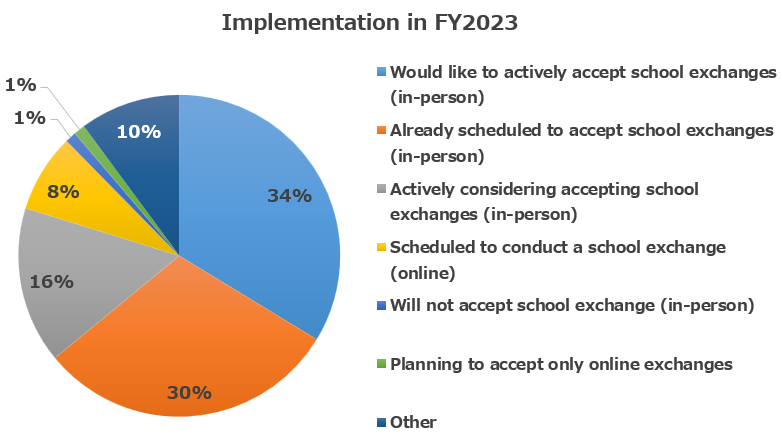
10.Information Required when Considering School exchange
We asked local governments and schools what kind of information they need when hosting schools from abroad in order to implement in-person school exchanges. The main responses were as follows
Information on partner school
The most common response was that they want information on any potential partner schools. Specifically, the school’s culture, characteristics, types of students, student population, and food allergies.
Preferred exchange content
Many respondents wanted to know what kind of exchange activities the other party was looking for. In addition to the program and time required, some respondents also wanted to know what element of Japanese culture they would like to engage in at the school.
Stories and exchange status of other schools
Quite a number of respondents expressed their desire to know how other schools are conducting exchanges and, if possible, they want to visit to observe what other schools are doing in order to formulate the content of an exchange in concrete terms.
11.Future issues for school exchanges (including online exchange)
The following responses were particularly numerous regarding future issues for school interactions, including online exchanges:
Acceptance system (including securing accommodations and personnel, and reducing burdens)
The development of activities, setting up accommodations, as well as reducing the burden on those in charge and costs, were cited as challenges. Several respondents mentioned difficulties in securing experienced staff in charge, especially since there had been no interaction for several years due to the COVID-19 pandemic. Since handovers have been insufficient, there is a need to check the procedures.
Sharing of information related to acceptance, selection and matching of partner schools
Many responses cited selecting schools to accept as an issue. There were also comments that there were so many inquiries that it took time to communicate and make arrangements. They also mentioned that it was difficult to find a school that would accept a large number of students.
Preparing and organizing schedules prior to the exchange
Many respondents answered that many visiting schools don’t finalize their itineraries ahead of time, request many changes, or cancel mid-way. This suggests that it could be more complicated to plan out in-person exchanges than online exchanges. Several respondents mentioned that it’s difficult to fix details due to slow responses.